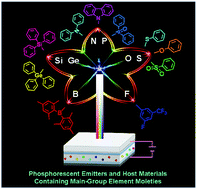Functionalization of phosphorescent emitters and their host materials by main-group elements for phosphorescent organic light-emitting devices
Abstract
Phosphorescent organic light-emitting devices (OLEDs) have attracted increased attention from both academic and industrial communities due to their potential practical application in high-resolution full-color displays and energy-saving solid-state lightings. The performance of phosphorescent OLEDs is mainly limited by the phosphorescent transition metal complexes (such as iridium(III), platinum(II), gold(III), ruthenium(II), copper(I) and osmium(II) complexes, etc.) which can play a crucial role in furnishing efficient energy transfer, balanced charge injection/transporting character and high quantum efficiency in the devices. It has been shown that functionalized main-group element (such as boron, silicon, nitrogen, phosphorus, oxygen, sulfur and fluorine, etc.) moieties can be incorporated into phosphorescent emitters and their host materials to tune their triplet energies, frontier molecular orbital energies, charge injection/transporting behavior, photophysical properties and thermal stability and hence bring about highly efficient phosphorescent OLEDs. So, in this review, the recent advances in the phosphorescent emitters and their host materials functionalized with various main-group moieties will be introduced from the point of view of their structure–property relationship. The main emphasis lies on the important role played by the main-group element groups in addressing the key issues of both phosphorescent emitters and their host materials to fulfill high-performance phosphorescent OLEDs.


 Please wait while we load your content...
Please wait while we load your content...